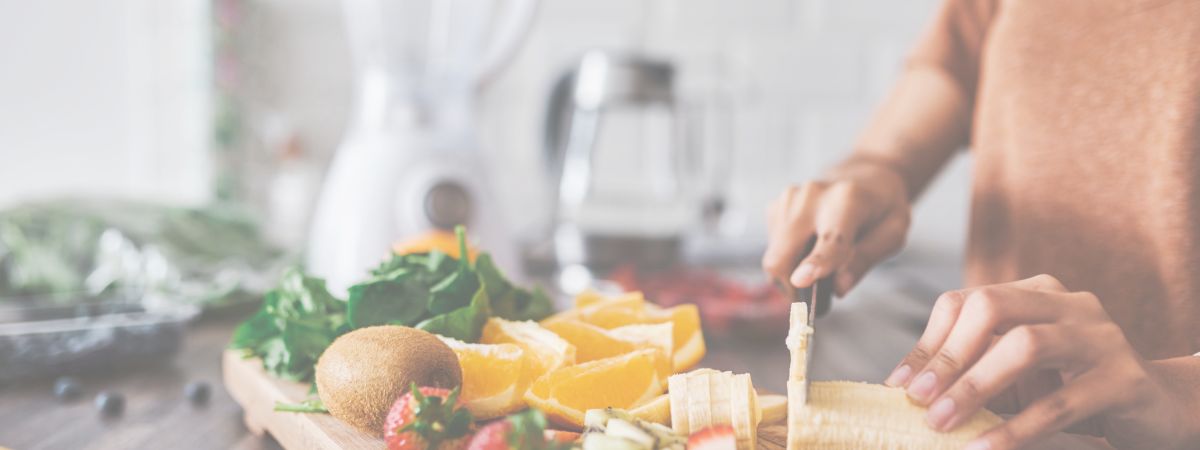We're all familiar with it—that midmorning, afternoon, or evening when we start looking for one, two, three, or more snacks.

The fact is snacking is largely intuitive and spontaneous (i.e., “It’s 3 p.m.—oh, I need some chips”).
The tricky part, however, is turning those grab-and-go moments into eating healthy portion amounts, mastering your worst cravings, and pumping up any lagging energy. Which these 4 easy steps to transform snacking will do.
Importantly, when snacking, listen to your hunger cues; don’t ignore or force them.
Generally, we need to be eating three meals a day, so if you’re doing that and not hungry between meals, there’s likely no need to be adding snacks.
On the other hand, if you're ravenous at those three meals and overeat, adding snacks might be a beneficial option. Be aware, though, that the quality of what you’re eating at those three meals can have a significant impact either way.
If, despite your best plans, cupcakes and/or a packet of chips still call your name, there may be something else going on. In the coming days, we’ll discuss issues around behavioural and environmental triggers.
So, think about what you’re already snacking on and how you can make small changes and improvements to make each choice count nutritionally.
Now, let’s walk through our Step-by-Step Meal Transformation guide and discover the 4 easy steps to transform snacking.
Step 1: Evaluate

What type of snacker are you?
- Impulsive: An impulsive snacker sees it and eats it. You’re more likely to pick up a snack near the checkout or grab a biscuit from an open packet on the table, then eat it straight away.
- Meal Replacement: These snackers regularly miss a core meal and then want something to refuel and keep them going.
- Indulgent: Stress, a busy schedule, the highs and lows of daily life, and emotional triggers cause many of us to seek solace in indulgent snacking. Even when you're not hungry, you quickly forget about any diet, food plan, or healthy snacks.
- Mindless: Umm, wasn't there a pack of biscuits there? You'll snack on food without realising it.
- All Day: They are unable to resist their intense hunger, leading them to skip meals due to their constant snacking. They struggle to distinguish between meals and snacks, leading to a blurring of their timing.
- Planned: Well done; you’re a premeditated snacker! You plan what you’re going to snack on, stick to a food plan, and don’t stray away from the basics. Your body is all the better for it.
Nielsen Study
In 2018, Nielsen conducted a survey on snacking habits in the UK, primarily as a resource for brands targeting shoppers. Here are some intriguing discoveries:
- 67% of shoppers are looking for “healthy” snacks, so the advice for brands is to include those claims in their branding.
- They noticed a considerable difference between weekend and weekday snacking. Weekday snacks are more functional focused (choices that give a boost or relieve a craving), and weekends are more indulgent and emotive.
- The most popular weekday snack type was fruit and vegetable-based products.
- Millennials are significantly more likely to purchase a snack due to a promotional offer. Gen X’s are more likely to be snacking as an indulgent treat. Baby boomers are more planned, seeking out healthier choices.
Regardless of the type of snacker you are, let’s consider reasons why you would or should improve your snacks:
Consider:
- Do you find your snacks are a similar size to your main meals?
- Are they loaded with salt, sugar, or fat?
- Do you eat carbohydrate-based snacks before protein-based snacks?
- Do you mistake thirst for hunger and prefer sweetened beverages?
- Do you choose low-fibre, low-fat snacks that won’t fill you up, resulting in you grabbing another snack shortly thereafter?
Conclusion:
If you're snacking on high-fibre and protein-based whole foods in a more planned manner, that's great.
On the other hand, if any of the aforementioned considerations resonate with you, or if you have a multitude of other reasons for wanting to modify your snacking habits, continue reading and consider taking a simple step to IMPROVE your snacking.
Step 2: Improve

Here are a few ways you can improve these snack choices and routine without making dramatic changes to what you’re actually snacking on:
- Keep a snack. a snack, not a meal: It’s obvious, it’s a "snack,” right! So a snack shouldn’t be the same size as a meal, but just enough to take the edge off your hunger; this, however, can be very challenging based on the type of snacker you are.
Remember, the 80% full practice habit when snacking between meals and always start with a smaller portion served first; you can always add if you’re not satisfied. Even if you’ve missed a meal and then snacked, stick to the 80% full. - How hungry are you? Snack only when you’re a little bit hungry, not simply because it’s become something that is part of your daily routine. So on a scale of 1 to 10, where 1 is starving and 10 is stuffed, how hungry are you? We’d suggest that you only need to snack when you’re at 3 or 4, and most won’t hit that mark until a few hours after a meal. But if you get there faster, it’s OK; have a bite.
- Avoid skipping meals: When you skip meals, you heighten the likelihood of intense cravings triggering an unintended snacking binge. Generally, eating a traditional three meals every 4-5 hours will help your body feel satisfied, leaving you less likely to snack excessively. However, if you prefer 4 or 5 smaller meals throughout the day, it’s unlikely you should feel the need to snack. But if you do, just follow the ‘how hungry are you’ rule.
Get Heaps more Whole Food and High Protein Recipes
+ Weekly Menu Plans
Join The STRONG ZONE Membership
Join NOW & Take Advantage of the 14-Day Trial Period
Step 3: Enhance

Great, you’ve made some simple changes but still know there’s more room for improvement. Let’s look at how you can enhance your snacking choices.
- Choose fresh: Fresh, particularly fruit and vegetables, is the simplest snacking choice. At home, work, or play, plan to always have these snacking choices readily available. Think creatively about the many ways to prepare and make them enticing. Consider using these fresh foods in smoothies as a great refreshing option. We’d suggest you avoid excessive juicing as it removes the important hunger-filing fibre, running the risk of overloading on sugars.
- Start prioritising fibre and protein: The ultimate snacks that keep you full for the longest period are those high in both fibre and protein. Think muesli with yoghurt, roasted chickpeas, veggie sticks with peanut butter, a fruit nut bowl, or veggies with hummus. These snack types will help keep you satisfied between meals and avoid overeating at main meals.
- Stay hydrated: If you feel a sudden hunger set in, try drinking a glass of water, then wait 5 minutes, as dehydration can be disguised as feelings of hunger. You may find the hunger feeling pass or subside. Should they persist, simply apply the fresh, fibre, and protein suggestions above!
Step 4: Optimise

Taking it to the next stage may need a little more time, but here’s how to optimise your snack choices even further:
- Develop a plan to have healthy snacks available most of the time: Always keep some healthy snacks on hand to avoid going to the cafe, vending machine, raiding the kids' school snacks, or worse, your partner's treat stash. Getting hungry when you’re on-the-go isn’t fun, so being planned with snacks can be a lifesaver in more ways than one.
So when it comes to those processed junk food snacks like chips, biscuits, lollies, chocolate, and pastries, keep them sparingly as treats. - Homemade: Use whole foods and make your own snacks with a mixture of fresh and baked ingredients. Don’t make it complicated either; otherwise, you’re not likely to sustain it. Experiment by replacing your favourite snacks with healthy versions. Possibilities could be replacing chips with homemade potato wedges or cutting up some veggies and making a dip or salsa.
- Become more mindful: Take a mind check and log where you’re eating snacks. Environments like watching TV, working on your computer, driving the car, etc. are activities that can make it difficult to listen to hunger and fullness cues. Instead, seek a designated place with minimal distractions, such as the dining room table, kitchen counter, or even your patio. Later in the 21 days we’ll unpack emotional eating triggers; it’s during these times that we typically make unhealthy snacking choices.
STRONG A.D.L. Movements
Establish ACTIVE DAILY LIFE Movements that last and support the lifestyle that you desire!

Your blog is a constant source of inspiration for me. Your passion for your subject matter is palpable, and it’s clear that you pour your heart and soul into every post. Keep up the incredible work!